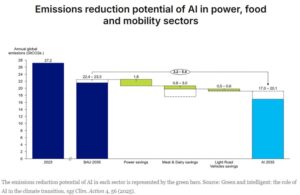Just transition could add 21% to GDP, the art of generation and happy birthday Sir William
In this issue:
Just transition could deliver 21% GDP growth
We haven’t heard much about the just transition in NZ in recent times but a new report from the UN Development Programme informs us combining policies to address poverty and improve livelihoods alongside a rapid transition to renewables could unlock US$20 trillion (NZ$33trn) in energy savings and uplift global GDP by 21% by 2060.
AI to save 5bn tonnes a year
We know the downside of AI in terms of its energy use but a recent paper from LSE (London School of Economics) and Systemiq tells us the energy use downside will be more than offset by benefits in fighting climate change. The analysis team looked at potential impacts on the food, power and mobility sectors, concluding emissions could be reduced by 5 billion tonnes a year across just those three sectors by 2035.
Offset demand already outpacing supply
That’s the conclusion on high integrity carbon credits according to a new report from Arbonics. The report focuses on European credits and reveals buyers are now much more discerning than only a few years ago, with a clear market shift to quality rather than price. While there are many schemes out there in the market, few are reaching the quality standards now being sought and very few are Europe based, meaning there will be increasing pressure on good quality, international credits from European buyers, especially as we head closer to 2030.
The art of generation
The Guinness Book of Records has just acknowledged the Sunrise building, in Edmonton, Canada, as the world’s largest solar mural. The building integrated photo voltaics (BIPV) cover around 3,200 square metres and carry 267 kW of capacity.
Lightning + air = ammonia
As well as being a principal ingredient of fertilisers, ammonia could also become an effective carrier of hydrogen. However, traditional production is carbon intensive requiring high heat, high pressure and fossil fuels. Researchers at the University of Sydney have come up with an alternative technique not reliant on the normal Haber-Bosch process. The new technique uses plasma to excite nitrogen and oxygen in the air, then converts the molecules into ammonia gas through a membrane-based electrolyser, avoiding the interim step of manufacturing liquid ammonia which then has to be turned into gas. The new technique is not only more sustainable in its manufacturing process, it could also lead to a more distributed production network, reducing transport costs and their associated emissions.
Did you know ……
The fuel cell was invented in 1842 and today (11th July) is the birthday of its creator, Sir William Robert Grove? Grove was the first to generate electrical energy from hydrogen and oxygen and found the process reversible, being able to separate steam into hydrogen and oxygen. He also created an early incandescent electric light, later refined by Edison. Grove was born in Swansea in 1811.


